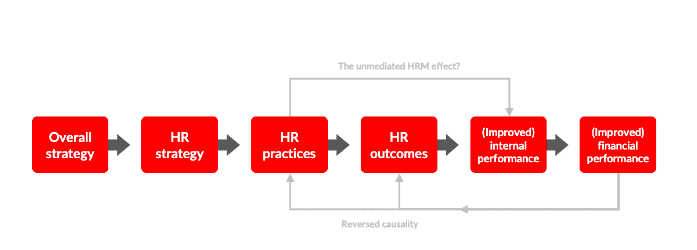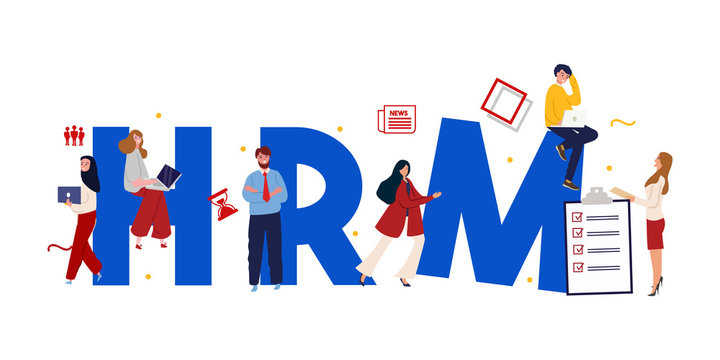The Standard Causal Model of Human Resource Management (HRM) is one of the most influential frameworks in the field of human resource strategy. Developed from several HR models introduced during the 1990s and early 2000s, it provides a clear understanding of how HR activities — when strategically aligned with business goals — can lead to improved organizational and financial performance.
This model illustrates a causal chain that begins with the overall business strategy and ends with enhanced financial performance, achieved through a series of HR processes, employee outcomes, and internal improvements. Let’s explore how this model works and why it is fundamental in modern HRM practices.
What is the Standard Causal Model of HRM
The Standard Causal Model of HRM explains how HR initiatives contribute to business performance by establishing a logical cause-and-effect relationship between HR strategies, HR practices, employee outcomes, and organizational results.
In simpler terms, it shows that HRM is not an isolated function; it must align with the overall business strategy to create measurable impact. According to the model, HR will only be effective if its strategies are in harmony with the organization’s goals — a principle known as the “best-fit approach.”
When HR strategies align with business objectives, they translate into specific HR practices (such as hiring, training, appraisal, and compensation). These practices then generate positive HR outcomes like employee commitment, engagement, and high-quality performance, which ultimately lead to strong internal operations and financial success.

The Causal Chain Explained
The Standard Causal Model of HRM can be visualized as a sequence of interconnected steps that link business goals to financial outcomes through HR processes.
Step 1: Business Strategy as the Starting Point
The model begins with the business strategy, which defines the organization’s long-term goals and competitive direction. HR’s role is to develop strategies that directly support these business objectives.
For example, if a company’s goal is innovation, HR must design programs to recruit creative talent, provide innovation training, and reward idea generation.
Step 2: HR Strategy Derived from Business Goals
The next step involves formulating an HR strategy that complements and reinforces the company’s overall direction. This ensures that people management initiatives — such as leadership development or workforce planning — are focused on achieving strategic outcomes.
Step 3: HR Practices Supporting the Strategy
Once the HR strategy is set, it is executed through HR practices, including:
- Recruitment and Selection: Hiring individuals with the right skills and cultural fit.
- Training and Development: Equipping employees with the knowledge and competencies required for success.
- Performance Appraisal: Measuring and rewarding performance aligned with organizational goals.
- Compensation and Benefits: Designing fair and motivating reward systems.
These practices serve as the operational tools that bring HR strategies to life.
Step 4: HRM Outcomes – Employee Behaviors and Attitudes
The result of effective HR practices is the creation of positive HRM outcomes such as:
- High employee commitment
- Increased job satisfaction
- Strong engagement and loyalty
- Improved quality of work
When employees feel valued and well-supported, they are more likely to deliver exceptional performance, contributing directly to the company’s internal success.
Step 5: Improved Internal Performance
Positive HR outcomes naturally enhance internal organizational performance. This includes:
- Higher productivity levels
- Increased innovation
- Enhanced work quality and efficiency
As internal performance improves, the company becomes more competitive, agile, and capable of achieving long-term objectives.
Step 6: Enhanced Financial Performance
The final link in the causal chain is financial performance, which reflects the tangible business benefits of effective HR management. Organizations that implement strategic HR practices often experience:
- Higher profit margins
- Better return on investment (ROI)
- Increased revenue growth and market share
In this way, HR initiatives contribute directly to the bottom line, proving that people are indeed an organization’s greatest asset.
Key Relationships in the Model
The Standard Causal Model highlights two important relationships that make it dynamic and realistic: the unmediated HRM effect and reversed causality.
a) The Unmediated HRM Effect
This concept suggests that certain HR practices can have a direct impact on performance, bypassing intermediate HR outcomes.
For example, effective training programs can directly improve productivity or service quality without necessarily passing through the stages of engagement or commitment. Similarly, a well-structured performance appraisal system can instantly boost motivation and results.
b) Reversed Causality
The model also acknowledges that the relationship between HR and performance is not always one-directional. Sometimes, strong financial performance enables a company to invest more in HR practices, which in turn further improves HR outcomes.
For instance, a financially healthy company may allocate more resources to training, employee development, or reward programs, resulting in greater engagement and satisfaction among employees.
Thus, the model recognizes that organizational success and HR practices influence each other continuously rather than following a strictly linear path.
The Role of Strategic Alignment in HRM
The essence of the Standard Causal Model lies in strategic alignment. HR can deliver real value only when its initiatives are directly linked to the business’s overarching strategy. This integration ensures that every HR activity — from hiring to performance management — supports the organization’s competitive priorities.
Key Aspects of Strategic HR Alignment:
- HR policies reflect the company’s mission, vision, and long-term goals.
- Employee development programs target future skill needs.
- Performance metrics connect employee success with business outcomes.
- Compensation systems reward behaviors that drive strategic success.
This alignment makes HR a strategic partner rather than an administrative function, driving measurable improvements in both internal and financial performance.
Conclusion
The Standard Causal Model of HRM provides a clear and logical framework for understanding how HR activities contribute to business success. By establishing a chain that connects business strategy → HR strategy → HR practices → employee outcomes → internal performance → financial performance, the model demonstrates the strategic value of human resource management.
It also emphasizes the importance of feedback loops, showing that success breeds further HR investment, creating a cycle of continuous improvement.
In essence, this model reinforces the principle that HR is not just about managing people — it’s about driving performance. When HR strategies are perfectly aligned with business goals, they create engaged employees, high-performing teams, and ultimately, a more profitable and sustainable organization.








